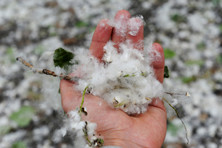Minnesota Environmental Public Health Tracking | |
Sniffling? Sneezing? It's pollen season  Pollen season, and accompanying allergy symptoms, have arrived. There are three pollen seasons in Minnesota. We are approaching the height of tree pollen, which lasts through mid-June. Knowing which pollen triggers your symptoms can help you prepare for the allergy season to reduce your exposure and symptoms. If you are allergic to a certain type of pollen, it is important to know when its season begins so you can begin taking medications in advance of that season. Pollen seasons are getting longer. The effects of climate change in Minnesota are already being seen. While climate change impacts everyone, certain populations are more susceptible to the health impacts. Some diseases or conditions are exacerbated by pollen. Asthma and chronic obstructive pulmonary disease (COPD), a chronic lung disease, are among the conditions that may be worsened by a longer allergy season and more pollen. What you can do: If you are allergic to a certain type of pollen, start taking your allergy medication in advance of the season and try to avoid pollen once it has begun. | | |
| |
Here are some additional steps to take if you have allergies: - Sign up for pollen alerts. You can get a pollen and mold report for the Twin Cities area from the National Allergy Bureau.
- Make sure you carry your asthma rescue inhaler with you.
- Limit your outdoor activities when pollen counts are high. This will lessen the amount of pollen allergen you inhale and reduce your symptoms.
- Keep windows (home and car) closed during pollen season and use central air conditioning with a HEPA filter in your home and vehicle.
- Wear a hat and sunglasses. This will keep pollen out of your eyes and hair.
- Shower and wash your hair before bed during high pollen days.
- Change and wash clothes worn during outdoor activities.
- Wash bedding in hot, soapy water once a week.
- Limit close-up cuddle time with your pets that spend lots of time outdoors.
See Asthma Quick Facts and Know Your Asthma Triggers for more information. The Minnesota Department of Health Asthma, Climate & Health and MN Tracking programs worked together to publish data about pollen seasons using pollen data collected in Minneapolis by the Clinical Research Institute. | |

No comments:
Post a Comment